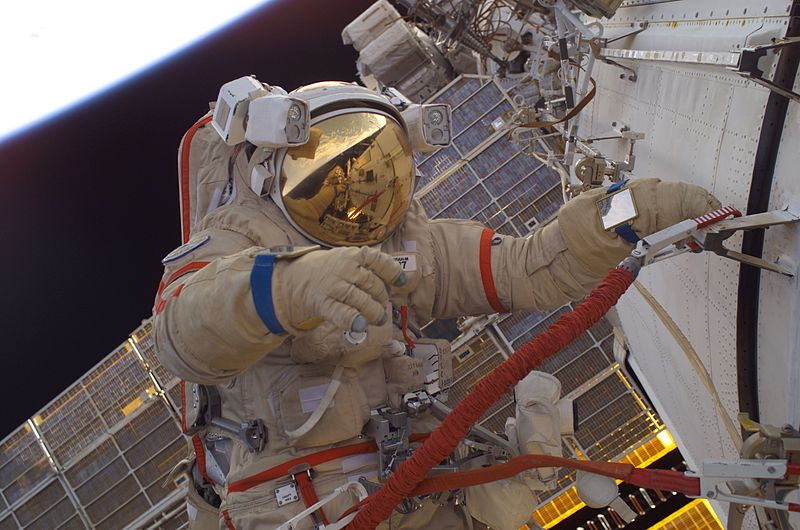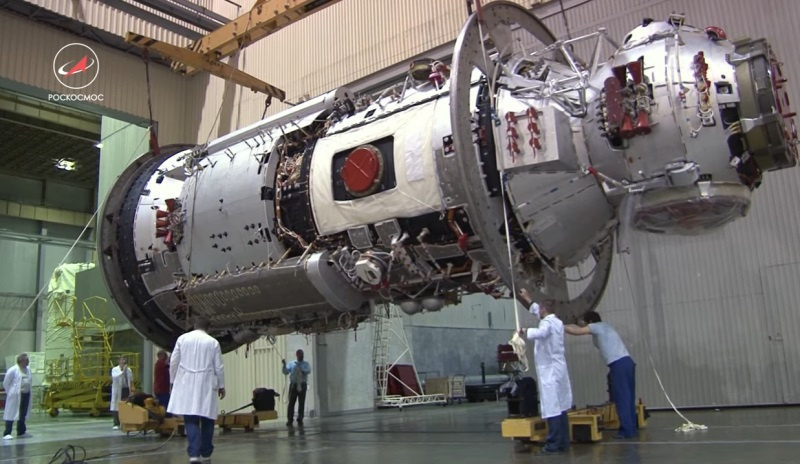That the Progress MS-06 truck will deliver to the ISS on June 16, 2017: overview of cargo, experiments and tasks
So, on June 14, 2017 from the Baikonur cosmodrome at 15:20:13 local time, the Soyuz-2.1a launch vehicle sent a Progress MS-06 cargo spacecraft flying to the ISS. The flight program is proceeding as planned and, after launching into an intermediate orbit, the truck will continue on its way to the station for two more days. At this time, we will consider the tasks solved by this launch and find out what is the connection between the launch of Progress MS-06 and the Science module.
The launch of the Progress MS-06 spacecraft using the Soyuz 2.1a launch vehicle from the Baikonur launch site (June 14, 2017).
So, RN Soyuz-2.1a has worked properly and now Progress MS-06 is moving towards the ISS. The launch of this truck was carried out according to the old scheme, that is, it will move in orbits until docking, not 6 hours, but 2 days. At the same time, according to the flight plan, the docking with the Zvezda module should occur on June 16 at 14:42 Moscow time. The reconciliation and docking of the spacecraft with the ISS are planned to be carried out automatically, but the Russian cosmonaut Fedor Yurchikhin , who is at the station, will control the automation , and in the case of an abnormal operation of the Kurs system, the docking control will be taken over.

The module of the Russian segment of the ISS “Star” with the Progress vehicle docked.
The main tasks during the mission of the Progress MS-06 spacecraft are:
The cargo delivered by the Progress to the ISS is quite standard: basically it is what allows cosmonauts to provide daily life (for example, 15 kg of fresh apples, adjika, mustard, horseradish and smoked sausages), as well as fuel for adjusting the station’s orbit.
For the reader, the nanosatellites displayed during the mission may be of much greater interest; we will consider them in more detail below. In addition, a few unscheduled cargo are the trouser legs and sleeves for the Orlan-MK spacesuit, and this is what it is.

Cosmonaut Sergey Krikalev during a spacewalk in the Orlan-M spacesuit.
But the fact is that at the end of 2016 it was planned to deliver to the station, including the new spacesuit Orlan-ISS , as part of the payload of the Progress MS-04 vehicle ., but since the cargo did not reach the ISS (the ship was lost ), the Russian crew had a shortage of protective equipment for going into outer space, with one exit scheduled for the end of this summer, and the new spacesuit was not ready yet. Therefore, it was decided that Progress MS-06 would deliver trouser legs and sleeves to the station, after which they would be attached to the rigid body of the old Orlan-MK space suit located at the station.
So, as mentioned above, Progress carries four nanosatellites on board. They are called "Tanyusha-UGZU" No. 1 and No. 2, "Sphere-53" and "TNS-0 No. 2". Actually, their launch is one of the tasks of our astronauts during the spacewalk planned for the end of summer (launches are scheduled to be carried out manually).
According to the adopted flight program, the entire stay in the Progress MS-06 station will be docked to the Zvezda module, although a slightly different flight program was originally planned.

Multifunctional laboratory module "Science", which should be part of the Russian segment of the ISS.
The fact is that the delivery plan for the Multifunctional laboratory module "Science" implies the connection of this module to the "Star" through the docking station, which currently contains another module of the Russian Pirs segment(this module has been part of the ISS since September 15, 2001, that is, almost 16 years). Therefore, it was originally supposed that Progress MS-06, during its mission, should be docked from the Star to the Pier, after which it will be de-orbited together with it. However, as we know, the launch of "Science" is constantly being postponed (this was written on GT here and here ), so now it is assumed that the Progress MS-09, the launch of which is planned for the end of 2018, will sink.
These are the tasks of the Progress MS-06 cargo spacecraft. It remains for us to wish Roscosmos success in carrying out the program of this mission, and the cosmonauts - soft docking and pleasant appetite.
The launch of the Progress MS-06 spacecraft using the Soyuz 2.1a launch vehicle from the Baikonur launch site (June 14, 2017).
So, RN Soyuz-2.1a has worked properly and now Progress MS-06 is moving towards the ISS. The launch of this truck was carried out according to the old scheme, that is, it will move in orbits until docking, not 6 hours, but 2 days. At the same time, according to the flight plan, the docking with the Zvezda module should occur on June 16 at 14:42 Moscow time. The reconciliation and docking of the spacecraft with the ISS are planned to be carried out automatically, but the Russian cosmonaut Fedor Yurchikhin , who is at the station, will control the automation , and in the case of an abnormal operation of the Kurs system, the docking control will be taken over.

The module of the Russian segment of the ISS “Star” with the Progress vehicle docked.
The main tasks during the mission of the Progress MS-06 spacecraft are:
- Delivery to the ISS of 2450 kg of cargo and equipment (for example, the trouser-legs and sleeves for the Orlan-MK space suit ), packages to the crew, food, 705 kg of fuel, 50 kg of oxygen and air, 420 kg of water;
- Delivery to the ISS of four nanosatellites (satellites with a mass of 1-10 kg) for their subsequent launch from the station;
- Finally, in December, it is planned to flood Progress MS-06 along with garbage from the ISS.
- Also, the truck initially had a mission to prepare the ISS for sending the “Science” module, but this part of the mission was postponed for a year and a half.
The cargo delivered by the Progress to the ISS is quite standard: basically it is what allows cosmonauts to provide daily life (for example, 15 kg of fresh apples, adjika, mustard, horseradish and smoked sausages), as well as fuel for adjusting the station’s orbit.
For the reader, the nanosatellites displayed during the mission may be of much greater interest; we will consider them in more detail below. In addition, a few unscheduled cargo are the trouser legs and sleeves for the Orlan-MK spacesuit, and this is what it is.

Cosmonaut Sergey Krikalev during a spacewalk in the Orlan-M spacesuit.
But the fact is that at the end of 2016 it was planned to deliver to the station, including the new spacesuit Orlan-ISS , as part of the payload of the Progress MS-04 vehicle ., but since the cargo did not reach the ISS (the ship was lost ), the Russian crew had a shortage of protective equipment for going into outer space, with one exit scheduled for the end of this summer, and the new spacesuit was not ready yet. Therefore, it was decided that Progress MS-06 would deliver trouser legs and sleeves to the station, after which they would be attached to the rigid body of the old Orlan-MK space suit located at the station.
1) Nanosatellites aboard the Progress MS-06 spacecraft
So, as mentioned above, Progress carries four nanosatellites on board. They are called "Tanyusha-UGZU" No. 1 and No. 2, "Sphere-53" and "TNS-0 No. 2". Actually, their launch is one of the tasks of our astronauts during the spacewalk planned for the end of summer (launches are scheduled to be carried out manually).
- “Tanyusha-YuGZU No. 1” and “Tanyusha-YuGZU No. 2” are nanosatellites, the main tasks of which are to test ways of communication between devices of this class in orbit, as well as to survey the Earth's surface. In addition, these devices will transmit to the radio air congratulations in honor of the 60th anniversary of the launch of the first satellite and the 160th anniversary of Konstantin Eduardovich Tsiolkovsky. This program will be conducted in Russian, English, Spanish and Chinese. The planned resource of the devices is from six months to one and a half years. The development of the satellites was performed by employees of the South-West State University in cooperation with the enterprises of the rocket and space industry. You can read about the previous works of UGZU employees here: Chaski-1 devices (here) and Tomsk TPU-120 ( here and here )
Congratulations of cosmonauts on the 120th anniversary of the Tomsk Polytechnic University from the ISS. In the frame, in the hands of Oleg Skripochka, is exactly the Tomsk TPU-120 nanosatellite (cosmonaut Alexey Ovchinin in the center , on the right - Yury Malenchenko).
Russian cosmonaut Yuri Malenchenko tells in detail about the Tomsk TPU-120 nanosatellite from the ISS. - Sphere-53 is a copy of the spacecraft launched from the ISS by astronauts Yuri Malenchenko and Gennady Padalka on August 20, 2012 (for this, astronauts also went into outer space). The tasks of the first "Sphere-53" included the refinement of atmospheric parameters at altitudes from 80 to 400 km and the search for space debris near the ISS.
- "TNS-0 №2" is a platform for testing and developing methods of working with satellites of the TNS series (TNS - technological nanosatellite). The main tasks are: testing new launch technologies from the ISS, as well as methods for controlling Earth remote sensing satellites and collecting telemetry through civilian communications systems. As part of this project, experimental testing of control technology from a single-point MCC (both stationary and mobile version) and two-way communication is carried out. Single-point MCC <-> TNS through the grouping of low-orbit cellular satellites Globalstar, MGTS and other cellular telephony operators. In addition, tests are planned new optical sensors of the orientation system. More information about the program, as well as about the predecessor of this device nanosatellite "TNS-0 number 1" can be found here .
2) Preparing for the launch of the module "Science" (task canceled)
According to the adopted flight program, the entire stay in the Progress MS-06 station will be docked to the Zvezda module, although a slightly different flight program was originally planned.

Multifunctional laboratory module "Science", which should be part of the Russian segment of the ISS.
The fact is that the delivery plan for the Multifunctional laboratory module "Science" implies the connection of this module to the "Star" through the docking station, which currently contains another module of the Russian Pirs segment(this module has been part of the ISS since September 15, 2001, that is, almost 16 years). Therefore, it was originally supposed that Progress MS-06, during its mission, should be docked from the Star to the Pier, after which it will be de-orbited together with it. However, as we know, the launch of "Science" is constantly being postponed (this was written on GT here and here ), so now it is assumed that the Progress MS-09, the launch of which is planned for the end of 2018, will sink.
These are the tasks of the Progress MS-06 cargo spacecraft. It remains for us to wish Roscosmos success in carrying out the program of this mission, and the cosmonauts - soft docking and pleasant appetite.
